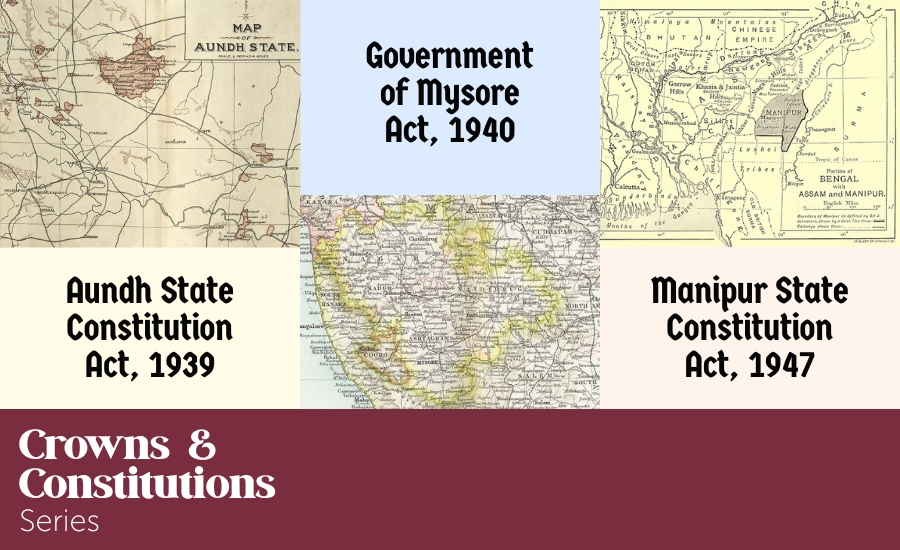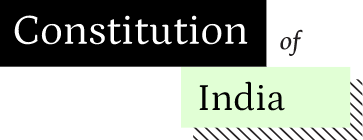
The previous post in the Crowns & Constitutions series examined who held legislative power, and the scope of that power, under the constitutions of the princely states of Aundh, Manipur, and Mysore. Continuing the series, this post turns to the question of rights. Before the Constitution of India came into force in 1950, certain princely states drafted their own constitutions. These documents marked early efforts to define the relationship between the state and its people. Aundh, Manipur, and Mysore each adopted constitutional frameworks that engaged with the idea of rights, in different ways. Rather than reviewing each constitution in isolation, this post explores how they approached the following shared themes: the types of rights these constitutions provided for, who was entitled to these rights, and how clearly the scope and limitations of these rights were articulated.
Varied Imaginations of Rights
The types of rights that these documents provided for varied widely. The Government of Mysore Act, 1940 was the narrowest in its conception. It didn’t mention civil liberties or social or economic entitlements. Instead, it allowed for elections to a proportion of seats in the Representative Assembly and Legislative Council– offering a thin form of political participation which can be thought of as political rights. Even this participation was subject to the Government’s (practically the Maharaja’s) discretion, which retained control over electoral participation and processes. In Mysore, the idea of rights was procedural, and controlled from the top.
The Manipur State Constitution Act, 1947 went further in its imagination of rights. It listed a set of “Fundamental Rights”, including equality before the law, personal liberty, and religious freedom. It also provided for elections to the State Assembly based on adult franchise (as defined by rules to be framed later). Further, the Act briefly referenced the guarantee of social and economic justice, though without much elaboration. This mention suggested that the state was conceived as having a broader obligations toward its citizens, to improve their conditions of life. This was especially true for the state’s ‘Hill people’, for whom specific provisions were made in addition to the general framework. These included the state’s responsibility for their ‘welfare and administration’, including through mandatory budgetary allocations; guaranteed seats in legislative institutions (see here and here); and the Hill representatives’ power in the State Assembly to block decisions that affected the group’s core interests.
The Aundh State Constitution Act I of 1939 was the most ambitious in its conception of rights. It guaranteed a wide set of civil, political, social, and economic ‘freedoms’- ranging from freedom of speech and assembly, to free basic education, to the right to work for a minimum living wage. While the list of rights was expansive, the document left most of the details of their scope and limitations to be decided by future laws, which weakened the enforceability of these rights. Nonetheless, the intention was clear: the state was responsible for more than just governance; it had a duty to improve people’s lives.
Who Was Entitled to These Rights?
Each constitution had its own idea of who could claim rights. In Mysore, the term used to denote the people’s relationship with the Maharaja was “subjects.” This was a revealing choice, one that kept the people in a subordinate position to the Maharaja. Voting and representation weren’t entitlements, but privileges granted by the ruler. There was no sense of equal citizenship or guaranteed status under the law.
In contrast, the Manipur Act spoke of “citizens” as the rights-bearers (see Chapter X). This shift in language signalled a different relationship between individuals and the state- one based more on legal standing than royal favour. The Constitution extended most rights to all citizens, and made special provisions for the ‘Hill people’. The inclusion of both individual and group protections pointed to a more inclusive vision of constitutional order. Citizenship here wasn’t flat or singular— it was layered, capable of recognising group-specific claims within a broader constitutional structure.
The Aundh Act also used the term “citizen”, but with some restrictions in its application. For example, the right to vote was limited to literate adults– a qualification that would have excluded many. While the vocabulary of citizenship was present, its application was partial. Still, the use of this vocabulary marked a shift toward thinking of people as active participants in public life, and not just passive subjects.
The Scope and Limitations of Rights
How far these rights extended— and how securely they were protected against potential limitations imposed by the state— also varied across the princely state constitutions. In Mysore, the limited political rights that were recognised remained firmly under state control. Elections were tightly managed by the Government (practically the Maharaja), which could decide on the qualifications to vote and be elected, how elections would be conducted, and how election-related disputes would be settled. Political representation existed in form, but not in substance.
Manipur’s Constitution provided more clarity on the citizens’ rights and their limitations. The text largely specified the scope and limitations of rights and included constitutional guarantees to safeguard them, particularly in the area of personal liberty. These guarantees included elements of a fair trial, and the state’s accountability for unlawful actions. Even though the social and economic rights were less developed within the text, there was atleast a basis for holding the state accountable. This is because the text recognised the state’s responsibility in the social and economic domains.
The rights under the Aundh Act were more generous on paper, but less secure in practice. Almost all of them were left to be defined through the “laws of the State”. This gave the law-making bodies wide latitude to (re-)define their scope. Further, broad ideas such as “public morality” and “non-violence” were cited as limits to these rights. These were vague and open to potential misuse. The result was a forward-looking list of entitlements without a strong legal foundation to protect them.
Overall, these three constitutions reveal a rich and complex picture. Mysore reflected a cautious and controlled model of governance, where rights were minimal and the power to define their contours was centralised. Manipur took a more balanced approach, offering both rights and guarantees for their realisation, especially for the Hill people. Aundh, idealistic and experimental, laid out a broad vision of social and economic justice. However, it lacked the legal precision needed to ensure this vision’s implementation.
Together, these documents show that the idea of rights was already in motion well before India’s independence. They show princely India not as a static or feudal space across the board, but as a place where different visions of law, governance, and citizenship were being tested. While these constitutional experiments were limited in scale and shaped by their historical contexts, they remain important in understanding how the language of rights evolved in India.
